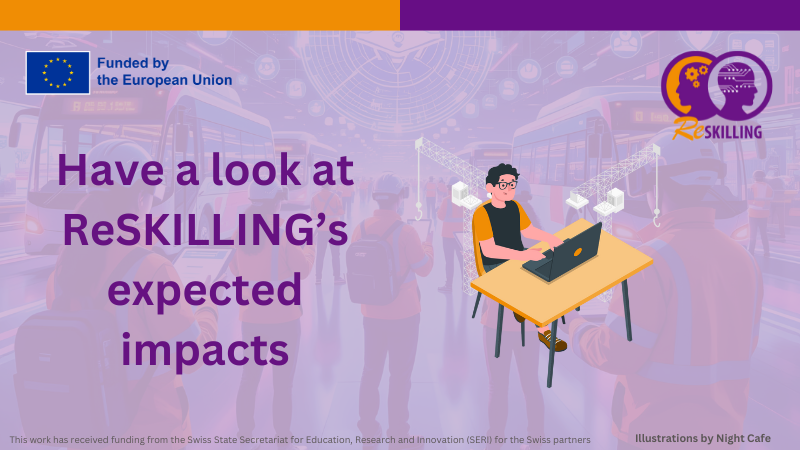How will CCAM reshape jobs and skills? Have a look at ReSKILLING’s expected impacts

ReSKILLING aims to implement a strategic approach that empowers the workforce and businesses of Europe's mobility (of people and goods) sector. The main objective of this approach is to effectively cope with the anticipated changes in the sector from Connected, Cooperative, and Automated Mobility (CCAM) deployment, but also to actively participate in advancing and refining the sector itself!
From this perspective, ReSKILLING will propose, implement, apply, and validate a comprehensive approach, guided by inclusivity, co-creation, and social innovation principles. This approach will efficiently coordinate a range of novel services and tools that implements optimal adaptation of the mobility sector to the deployment of CCAM solutions and services. The approach measures will encompass the analysis of the socio-economic and employment impacts of CCAM across the entire value chain to facilitate businesses and workers in mitigating drawbacks and leveraging opportunities of CCAM deployment.
Where will ReSKILLING make a difference?
Following the methodology proposed by the EU-CEM Handbook for CCAM1, ReSKILLING will address its impacts on following impact areas:
- Society impacts focus on economic activity, employment, socio-economics, and equity, reflecting the project’s mission to strengthen workforce skills and promote fair job opportunities in the age of transport automation.
- Human impacts address quality of life, examining how CCAM-related job transitions influence well-being, satisfaction, and occupational health.
- Transport system impacts explore services and operation, assessing how skilled workers can improve service quality, scalability, and the viability of business models for automated mobility.
How will we measure the ReSKILLING’s expected impacts?
To make these dimensions measurable, ReSKILLING had defined a structured set of Key Performance Indicators (KPIs) and their corresponding research questions, providing a roadmap for evaluating the project's success and broader implications. Here is a summary of the KPIs by impact area:
- In terms of societal impacts, the ReSKILLING project will gather insights based on the number of jobs and businesses involved and their productivity (Economic Activity and Employment). Within the socio-economic and equity dimensions, key indicators such as societal cost and the distribution of skills development benefits will be crucial to understanding how project activities generate inclusive growth.
- In terms of human impacts, the project will assess public health (particularly in relation to occupational well-being in new CCAM jobs) and livability, as strong and stable employment can significantly enhance community well-being.
- In terms of transport system impacts, the project will analyse operational costs, quality of service, scalability, replicability, and business model viability, together with training modules, strategies, pathways, and business toolkits developed to validate the approach in future CCAM deployments.
Anticipating impacts for an inclusive and sustainable transition
Ultimately, ReSKILLING demonstrates that anticipating workforce impacts is as crucial as advancing technology. By embedding employment and (reskilling) considerations within the broader assessment of CCAM, the project supports a more inclusive, equitable, and sustainable transition toward automated mobility.
ReSKILLING involves innovating business models and uses mechanisms and training tools for skill enhancement and adaptation, with an emphasis on their replication and transferability potential and customised scalability for adoption throughout the EU. ReSKILLING aspires to create a CCAM innovation system capable of not only generating innovation but also delivering solutions to societal challenges.
1 European Common Evaluation Methodology Handbook for Connected, Cooperative and Automated Mobility (FAME, 2025), https://www.connectedautomateddriving.eu/wp-content/uploads/2025/05/EU-CEM-Handbook_FINAL_public_version_1.pdf